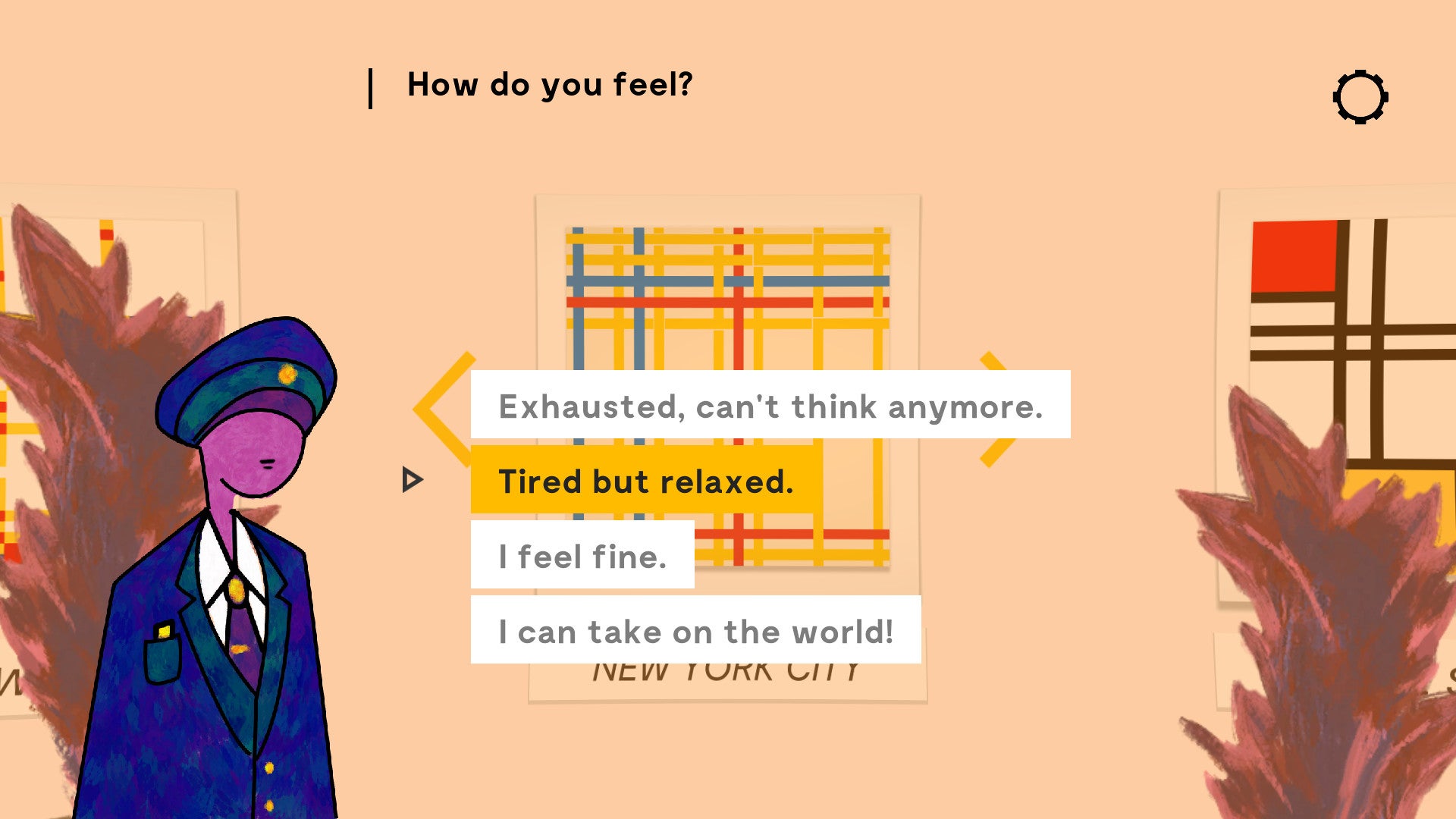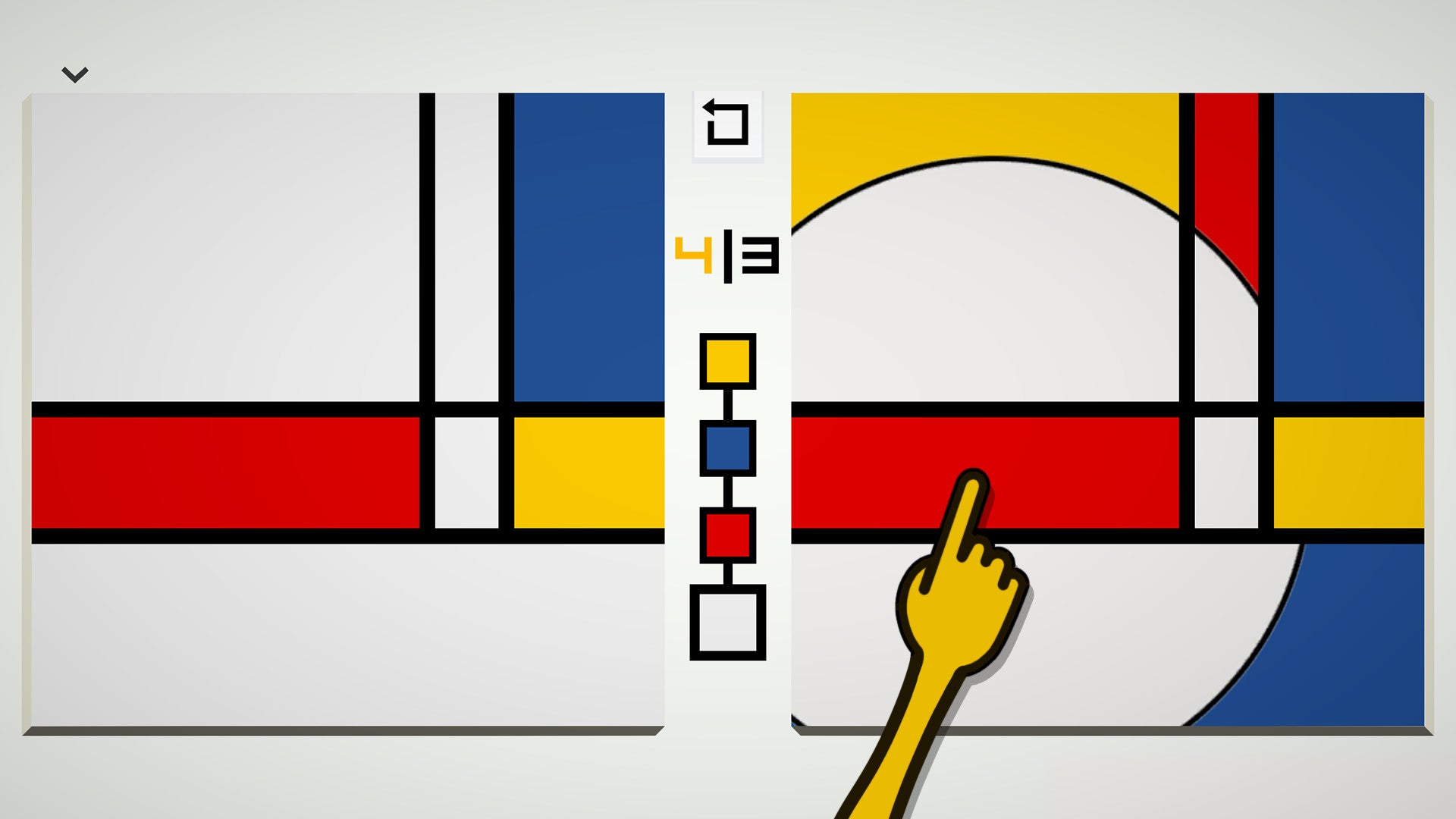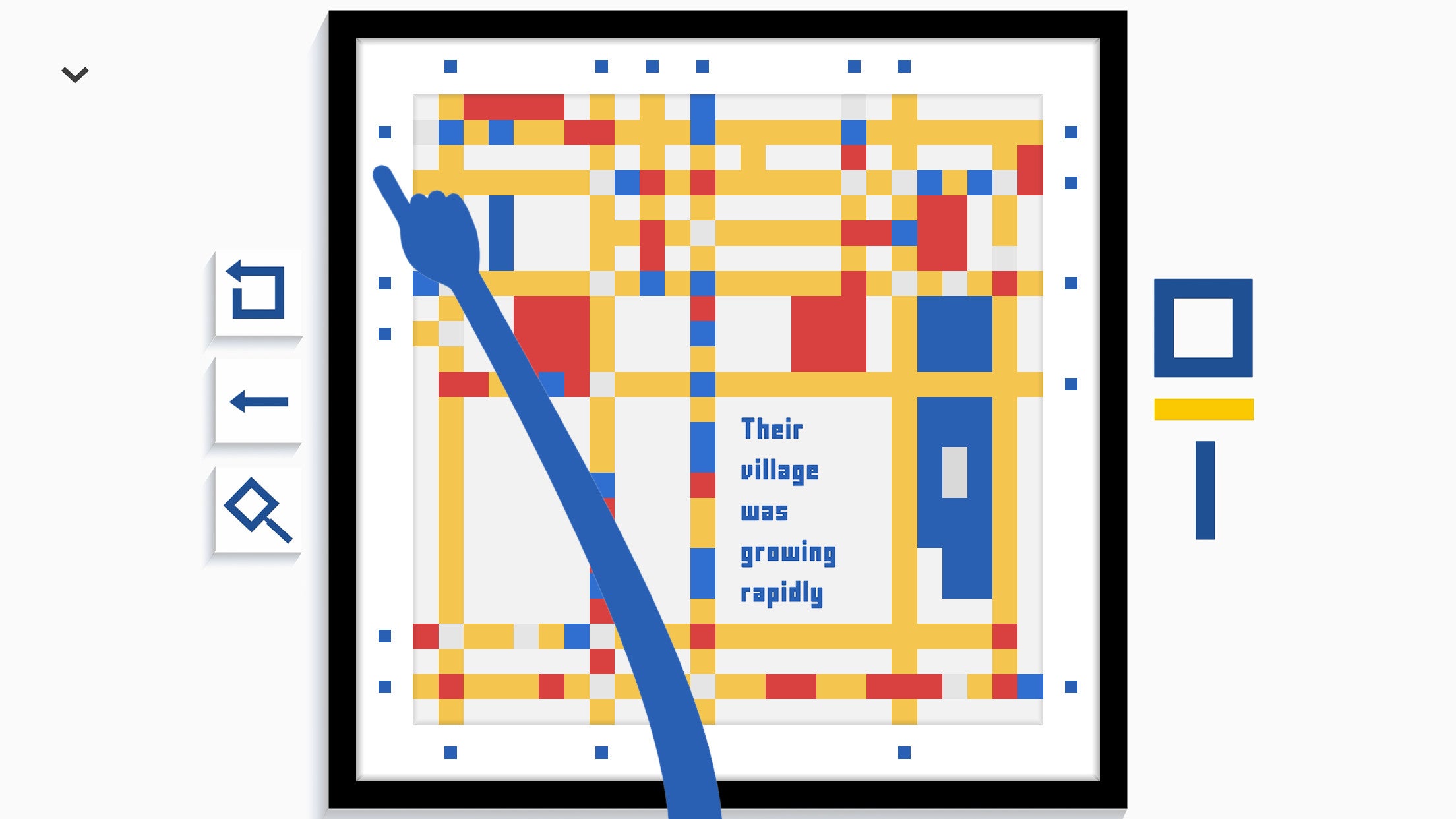Oh, and he’s also the kind of artist that makes a certain kind of person say, “Well, I could’ve done that. Give me a ruler and a bunch of red and black and blue and yellow paint, and I could knock out Mondrians all day.” Look at those elements of the classic Mondrian - again, the grid-based L’Oreal Mondrian that most easily comes to mind. Black lines. Blocks of flat colour. This Mondrian is surely a creature of MS Paint? So even at this level, Please, Touch the Artwork does people like me a service. Those lines and blocks look so simple, but working on your own Mondrians turns out to be surprisingly hard to do. You can have all the pieces of the L’Oreal Mondrian, the lines, the right colours, and it just looks wrong. Actually, it’s really tricky to get it to look right. Please, Touch the Artwork is a playful puzzle game inspired by abstract art. But it’s also, I think, something else. It’s an attempt to get you to see the art afresh, to see it as part of a lineage that can be understood, to see the way it has evolved and shifted forms over time, and to have a go yourself in a manner of speaking. By using three abstract paintings as the foundations for three types of puzzle, Please, Touch the Artwork encourages you to dabble in the process of abstract art, which is the part of art that we generally don’t get to see. You may be trying to solve something in the game, to beat a level, but you’re also making choices, thinking critically. The first wall to an appreciation of abstract art - that the art is, you know, finished, and hanging in a gallery and you can only get so close - that wall comes down. Please, touch! See what you can do. For me it was a revelation. The puzzles are fine and sometimes great. Not to spoil the artworks too much, but in the first series of puzzles, you work on matching those classic Composition-type Mondrians - making your canvas on the right look like the work on the left. You create lines. You touch blocks to spread colours to any contiguous walls, as if the whole thing was a sort of arty cellular automaton. There are hints for when you get stuck, but the core fun is in experimenting, taking a canvas between various states, rescuing a disaster. In between this, you get bits of history and anecdote and theory. At one point you get what amounts to a cut-scene in which you can see Mondrian inching towards truly being Mondrian - the natural world grows more angular, wildlife gives way to human design, lines that are almost straight, colours that are almost flat expanses. And yet you also see that, looking backwards, the lines and the abstraction were there from the start too - that windmill he painted back in 1908 or whatever is already throbbing with edges and colour, as if it’s itching to burst open and become pure shape and tone. Each of the three puzzle series has insights like this. In the second, very broadly, you work to unite different shapes by pinging them around the crossing lines of a series of paintings inspired by Broadway Boogie Woogie. It’s all about understanding the rules of the grid - where it will take a piece that you have launched into it - and it’s also about making sure you find the right order of moves. At times, it’s a bit too much for me. In the third series you start off by playing what amounts to a game of Blockade, or Snake, collecting letters as you go, moving through expanses that have come from Mondrian’s New York City. I love it: wriggling through pipes, turning back on myself, finding a letter in a seemingly impossible spot. This, like all the challenges, will grow in complexity as you work through the game. They all evolve, the way that an artist’s work evolves. Opportunities appear and are exploited. Analogies and interpretations suggest themselves. But here you aren’t just looking at the finished piece, you are part of that thrilling, unpredictable process, so the opportunities and analogies and interpretations are all available to you, as well. You get to sit closer to the artist while they are thinking. That question of placement is key here I reckon. Part of the problem with art is that you often see it in the same places - maybe the wrong places. Galleries, yes, which with their churchy silences and creaking floors encourage a certain kind of viewing. But also, take someone like Kandinsky: flung in the humming corridors of Marriots to off-set the carpet, or covering the walls of a dozen media departments in universities around this country and possibly most countries. It can be hard to get a sense of Kandinsky in places like that. But this is just the staging, I try to tell myself. It’s not the art. As hard to separate things as I often find it, it is possible. One of my favourite photos in the world is of Las Meninas by Velazquez, a favourite painting which hangs in a favourite room in the Prado, a favourite museum in Madrid. (A favourite city.) Pretty ideal, I guess. But in this photo Las Meninas is somewhere else. It’s wartime, and the painting has been taken out of the gallery and away from the city for safe-keeping. Here it is out of doors, surrounded by the people who have been tasked with protecting it. And what you see in this dangerous instance, in this accident of history, is that the real people and the painted people blend, and that this painting, which captures a moment, is also ready to spill that moment out into the world of today. This is its gift. Well, one of its gifts. Sorry for banging on about Velazquez yet again (he’s the only painter I really know in any meaningful way), but this is the power of Please, Touch the Artwork. It gets you to ignore the gallery, and it gets you through the frame. It’s a prompt in how to engage with abstract works, which, by their nature, have a few more hurdles before you can get to grips with them. I dreaded writing this review, because I thought I would have to bone up on Mondrian, one of those artists who had such a firm idea of what their work meant, what it should be seen as doing. I thought I’d have to learn the arguments and then spew them out to make sense of the game I’d just played - to make Mondrian’s arguments my own, despite the fact that they have never sparked anything in me at all apart from that sense of not being able to totally get it. And yet halfway through playing I realised I didn’t have to do that. I was beyond the gallery, through the frame, and thinking back to one of the few times I’d seen a Mondrian in the flesh and leant in close. And like absolutely everyone who gets to lean in close I discovered that the MS Paint cleanness - the Euclidean starkness of the lines, the fill tool blanks of the colours - that was all a mirage. Get in close and the lines stop before the edges of the canvas and the black creeps beyond the borders. The squares of red and blue and yellow reveal individual brushstrokes - are, in fact, surprisingly textured. Reading around a bit, lots of people have had this moment of almost being shocked by the reality of the materials in a Mondrian, the materials and how they are used. So what, then: these paintings themselves are but a human approximation of something ideal, purely abstracted, that Mondrian was still reaching for? Or does it go even deeper? Is the roughness, the clash of clarity and compromise, what he was after all along? I don’t know, but it’s certainly something to think about. And that’s it: this game plays with paintings, but it also gave an entire painter back to me. It rescued him from the list of artists who make me feel a bit dim. And I’m very grateful.



